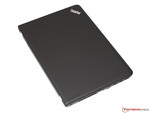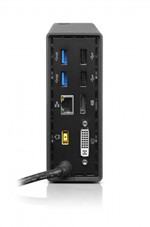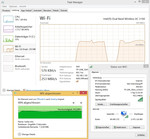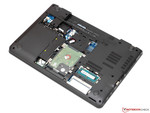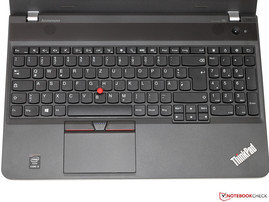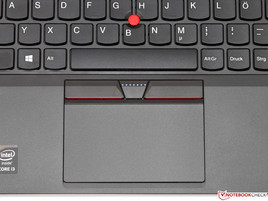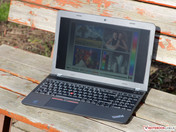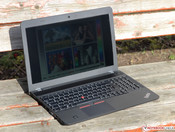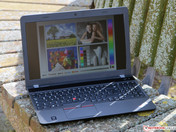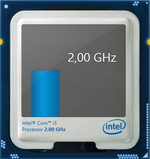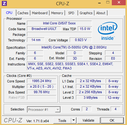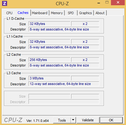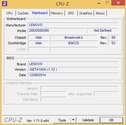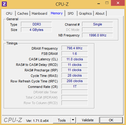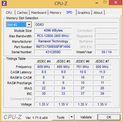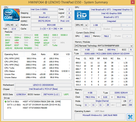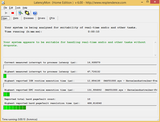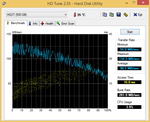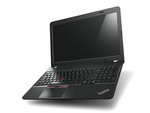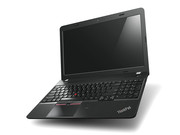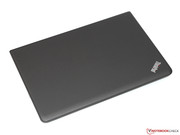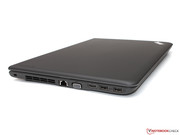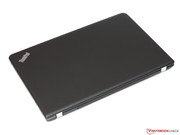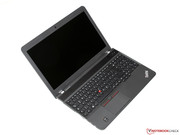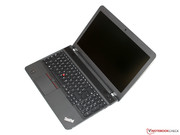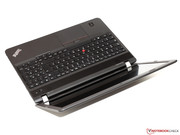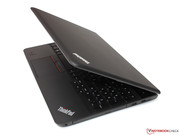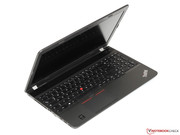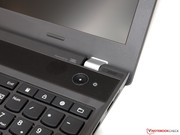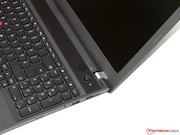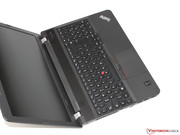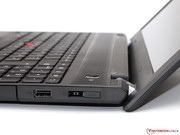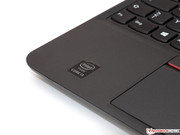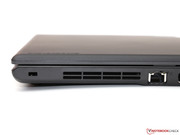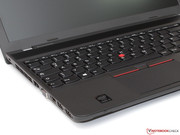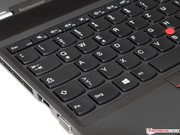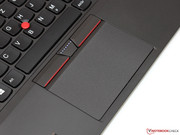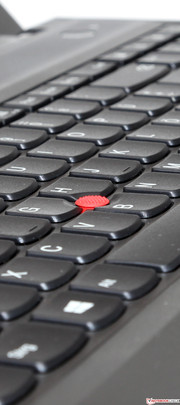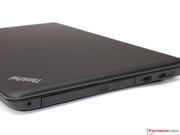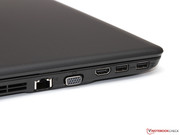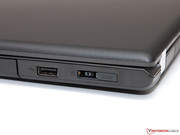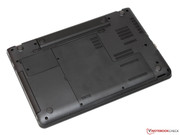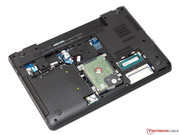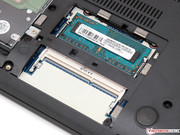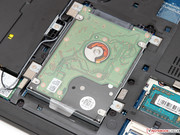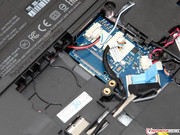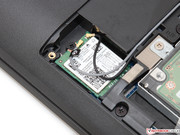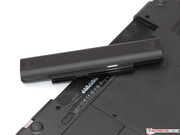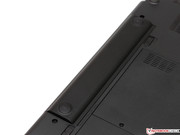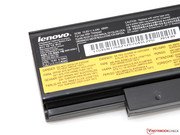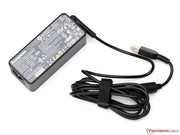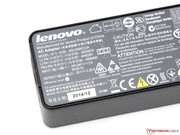Lenovo ThinkPad Edge E550 Notebook Review

For the original German review, see here.
Even if the name is virtually identical, the basic office laptops from the ThinkPad Edge lineup only have little in common with traditional business machines like the ThinkPad T450s. Instead, Lenovo wants to capitalize on the lower price ranges with its well-known name - that is not at all reprehensible as long as the price-performance ratio is correct.
The manufacturer now introduces yet another scion of the lineup dubbed ThinkPad Edge E550 (also simply known as ThinkPad E550). The most significant modification is doubtlessly the change to Intel's Broadwell ULV platform in contrast to the precursor that was still based on standard voltage CPUs from the Haswell generation. The entry-level configuration at hand incorporates a Core i3-5005U alongside 4 GB of RAM and a 500 GB HDD storage device. The matte, 15-inch screen has a resolution of 1920x1080 pixels. This model is available to students and pupils for around 550 Euros (~$583) in the frameworks of Lenovo's Campus program (no operating system). Standard configurations tend to be a bit more expensive. An overview of the alternative configurations is listed in the chart below.
In the following test, we would not only like to let the ThinkPad E550 compete against contenders like HP's ProBook 450 G2 and Acer's TravelMate P256-M. We would also like to compare it with the former ThinkPad Edge E540 with special focus on the impact that the economic hardware has on performance and emissions.
Overview of configurations (w/o Education Discount, excerpt):
| ThinkPad E550 (20DF0051GE) | ThinkPad E550 (20DF004TGE) | ThinkPad E550 (20DF004UGE) |
|---|---|---|
| Core i3-5005U | Core i5-5200U | Core i7-5500U |
| 4 GB RAM | 4 GB RAM | 8 GB RAM |
| 500 GB (HDD) | 500 GB (HDD) | 1000 GB (HDD) |
| HD Graphics 5500 | Radeon R7 M260 | Radeon R7 M260 |
| TN screen, 1366x768 pixels | TN screen, 1920x1080 pixels | TN screen, 1920x1080 pixels |
| starts at 600 Euros (~$636) | starts at 780 Euros (~$827) | starts at 920 Euros (~$976) |
Case
The Edge E550 is one of the few ThinkPads of the 2015 generation where Lenovo visibly reworked the casing. Principally, the matte-gray chassis is still based on a plastic construction (PC / ABS) that does not have additional metal struts. Despite that, the display and base unit prove to be very rigid. The surface first yields noticeably when high pressure in places or excessive warping attempts are made. The manufacturer has obviously favored stiffness over mobility here. The 2.38-kilogram heavy and 27-millimeter thick E550 is not exactly portable.
Considering the low purchase price, the display's tightly pulled hinges are also convincing. Although they do not allow one-hand opening or an opening angle beyond approximately 135 degrees, they have a firm hold on the lid even during strong vibrations. We did not like the sharp edges on the outer bezel where the front and back of the two-piece display meet as much. Also, we discovered similar manufacturing flaws, such as inaccurate material transitions or uneven gaps, on other parts of the casing. This does not lead to functional restrictions, but a better quality control would be welcomed.
Connectivity
Still only two of the three USB ports support the high-speed USB 3.0 standard, which does not seem very logical in view of the modern Broadwell platform. It's also too bad that both the VGA (analog) and HDMI (digital) video outputs only officially support a maximum resolution of 1920x1080 pixels. Unfortunately, the ThinkPad does not feature a (mini-) display port, which is particularly needed for high-resolution monitors. However, none of the contenders have one, either. The interface diversity is completed with the usual standards like Gbit LAN, a headset jack, and card reader (SD/MMC).
Although the E550 does not have a conventional docking port, the listed connectivity can be expanded. Lenovo installs a special power-in socket for this purpose. So-called OneLink Docks - a small box that is placed beside the laptop - can be connected to it. The pro-version sold for around 130 Euros (~$137) even features the missing display port.
Communication
A mini-PCIe wireless adapter from Intel is inside our review sample. However, it is not the current top model Wireless-AC 7265 but the slightly less expensive Wireless-AC 3160 version. Although it supports exactly the same radio standards in form of Bluetooth 4.0 and Wi-Fi 802.11 a/b/g/n/ac (2.4 and 5 GHz), it only achieves 433 Mbps gross because it is limited to single-stream transmissions. This is not a major drawback in practical use. The module only lagged behind the bigger model by roughly 10 to 15 Mbps with the ascertained 30 Mbps (TP-Link Archer C7, 802.11 ac) in ideal reception conditions. Furthermore, we can confirm that the ThinkPad has a stable and high-range connection.
As so often, the 0.9-megapixel webcam installed in the display bezel, unfortunately, only provides very moderate results. Lack in detail, faded colors, and strong noise characterize the image impression, making it at most suitable for Skype and co. However, the very clear dual-array microphone did not give us reason for complaint.
Security
Despite the ThinkPad label, the E550 is more a member of the consumer category, and thus it hardly has any security features. A TPM or fingerprint scanner are only found in exclusive models.
Accessories
Our Campus model without an operating system is not shipped with driver CDs or any other accessories. The needed drivers and system tools for installing Windows 8.1 64-bit at a later date are, however, easy to find on Lenovo's support website. The manufacturer also still completely supports Windows 7.
Maintenance
There are two maintenance covers on the device's underside, which enable accessing the most important hardware components. A 2.5-inch, 7-millimeter hard drive, Wi-Fi module and working memory (1 of 2 banks filled) but not the casing's fan belong to that. Interesting: soldering points on the motherboard indicate a preparation for an M.2 slot, which our model did not have. It is possible that configurations with a mobile network adapter or an M.2 SSD are planned in the future.
Warranty
As standard for this price range, The E550 only includes a 12-month warranty. However, extending this period with one of the fairly inexpensive upgrade packages (bring-in service: 24 / 36 months starts at 32 / 58 Euros, ~$33 / ~$61) would seem recommendable.
Input Devices
Keyboard
The looks and layout of the E550's keyboard are identical with those of higher-priced ThinkPads, such as the T550. However, there are some differences, which is not surprising considering the massive price difference. In addition to the lack of a backlight, it primarily concerns the typing feel that cannot quite compete with the pricier sister model. Although our review sample stands out with its long drop and firm stroke, the pressure point let us slightly miss the rich, mechanical feedback of the T series. That also became evident in the somewhat higher-pitched clattering when typing energetically. But we are complaining on a high standard. Compared with the direct contenders, the keyboard alongside its integrated number pad makes an impeccable impression and thus allows typing swiftly.
Touchpad
Like in all ThinkPads of the 2015 generation, Lenovo also installs the revised UltraNav unit in the E550, which again features dedicated TrackPoint keys. The keys' soft and accurate response prove to be a real plus point after a short time, and we ask ourselves why the manufacturer did not modify the touchpad in the same manner. Instead, a so-called ClickPad is still used where the buttons are incorporated into the 10 x 5.6 centimeter input area. In particular, drag'n'drop is slightly more difficult, but the pad functions overall more reliably than in the past - likely also due to the updated driver. More experiences regarding both input devices can be found in the review of the ThinkPad T450s.
Display
The E550 features either a WXGA (200 cd/m²) or a Full HD screen (220 cd/m²), depending on the configuration. However, the latter is primarily reserved for the higher-priced configurations. Our relatively reasonably priced review sample proved to be a welcome exception and displays a whole 1920x1080 pixels on the 15.6-inch screen. The resulting pixel density of 141 ppi (WXGA model: 100 ppi) is a successful compromise of focus and font size - which is an important issue since many older applications cannot be scaled at will under Windows 8.1.
Apart from the decent resolution, the TN-based, Full HD screen from AUO is not really compelling. The ThinkPad's maximum brightness of just 210 cd/m² is slightly outclassed by both the TravelMate P256-M (230 cd/m²) and ProBook 450 G2 (225 cd/m²). Nor is the contrast ratio of 331:1 exceptionally high and gives the E550 a lackluster and weak image impression. Black areas never look really rich and always look a bit grayish particularly in low-light conditions. However, the purchase price should be kept in mind - a high-quality IPS screen like in the Dell Latitude E5550 has its price.
| |||||||||||||||||||||||||
Brightness Distribution: 89 %
Center on Battery: 228 cd/m²
Contrast: 331:1 (Black: 0.688 cd/m²)
ΔE ColorChecker Calman: 10.04 | ∀{0.5-29.43 Ø4.78}
ΔE Greyscale Calman: 10.65 | ∀{0.09-98 Ø5}
38.8% AdobeRGB 1998 (Argyll 1.6.3 3D)
42.06% AdobeRGB 1998 (Argyll 3D)
61.1% sRGB (Argyll 3D)
40.69% Display P3 (Argyll 3D)
Gamma: 2.53
CCT: 12807 K
| Lenovo ThinkPad Edge E550 1.920 x 1080 Pixel (TN-Panel) | Acer TravelMate P256-M-39NG 1.920 x 1080 Pixel (TN-Panel) | HP ProBook 450 G2 L3Q27EA 1.920 x 1080 Pixel (TN-Panel) | Dell Latitude 13 3540 1.920 x 1080 Pixel (TN-Panel) | |
|---|---|---|---|---|
| Display | 36% | -7% | 18% | |
| Display P3 Coverage (%) | 40.69 | 56.3 38% | 37.91 -7% | 48.49 19% |
| sRGB Coverage (%) | 61.1 | 81.1 33% | 56.9 -7% | 70.3 15% |
| AdobeRGB 1998 Coverage (%) | 42.06 | 58.2 38% | 39.2 -7% | 50.4 20% |
| Screen | 2% | -1% | 37% | |
| Brightness middle (cd/m²) | 228 | 232 2% | 254 11% | 240 5% |
| Brightness (cd/m²) | 210 | 230 10% | 225 7% | 222 6% |
| Brightness Distribution (%) | 89 | 82 -8% | 84 -6% | 80 -10% |
| Black Level * (cd/m²) | 0.688 | 0.66 4% | 0.72 -5% | 0.33 52% |
| Contrast (:1) | 331 | 352 6% | 353 7% | 727 120% |
| Colorchecker dE 2000 * | 10.04 | 12 -20% | 10.73 -7% | 4.63 54% |
| Greyscale dE 2000 * | 10.65 | 12.65 -19% | 11.23 -5% | 5.07 52% |
| Gamma | 2.53 87% | 3.09 71% | 2.21 100% | 2.54 87% |
| CCT | 12807 51% | 14904 44% | 13321 49% | 8415 77% |
| Color Space (Percent of AdobeRGB 1998) (%) | 38.8 | 53 37% | 36.2 -7% | 44.95 16% |
| Total Average (Program / Settings) | 19% /
11% | -4% /
-2% | 28% /
32% |
* ... smaller is better
The screen exhibits an intense bluish cast with the default color profile, and that is one of the reasons for the strong shifts in our color and grayscale measurements (DeltaE 10.04 and 10.65). Calibrating the screen improves the RGB balance and results in considerably lower DeltaE rates. However, the screen remains unsuitable for professional image editing due to its limited color space (AdobeRGB: 38.8%; sRGB: 55.7%).
Despite its AR-coated surface, the ThinkPad Edge is not recommendable for outdoor use. That is not only due to the laptop's size and weight, but also the screen's brightness of just over 200 cd/m². That is simply too little to ensure unrestricted legibility particularly on sunny days. Thus, the user would either have to look for a shadowy place or stay at the desk from the outset - that is definitely more the E550's comfort zone.
For technology-related reasons, a TN screen will never achieve the same viewing-angle stability as an IPS screen. However, there are sometimes extreme differences even among screens with the same build. Our review sample exhibited severe image deviations in the slightest vertical shifts, and it is not advisable to move too much horizontally, either. That is not a very satisfactory result even for a TN-based model.
Performance
After testing several Core i5 and Core i7 CPUs from Intel's new Broadwell generation in the past few weeks, we are now facing a slightly cheaper version for the first time with the Core i3-5005U. The 2.0 GHz dual-core does not feature a CPU Turbo, which is typical for Core i3s. However, it does have Hyper-Threading for processing up to four threads simultaneously. As an economic ULV model, the chip, built in a cutting edge 14-nanometer process, has a TDP of a low 15 watts, including PCH.
The processor-integrated HD Graphics 5500 is responsible for graphics calculations. Of the actual 24 execution units (EUs) of this mid-range GPU configuration level, one is disabled in the Core i3 models, and thus only 23 EUs with a clock rate of 300 to 850 MHz are effectively available. Lenovo additionally installs a dedicated AMD Radeon R7 M260 with a performance level between an Nvidia GeForce 820M and GeForce 830M in some models.
A single 4 GB, DDR3L-1600 module has to cover the RAM requirements of Windows and programs, and thus the memory controller only operates in the slow single-channel mode. The 500 GB hard drive does not exactly excite us, either. At least both components can be upgraded easily like we described in the section concerning maintenance.
Processor
It could be said that the different Core i3 models are perhaps the most interesting models of the recently introduced Broadwell lineup. Unlike the Core i5 and Core i7 members, Intel has considerably increased the clock rates of some - from the Core i3-4005U (1.7 GHz) to the Core i3-5005U (2.0 GHz) by almost 18%, for example. Then there is the approximately 5% higher per-MHz performance of the improved micro-architecture. As expected, that equals a total advantage of about 23% in contrast to the mentioned Haswell precursor, which is found in the TravelMate P256-M, among others.
That is, however, only one side of the coin - after all, we do not want to forget that the ThinkPad E lineup was equipped with standard 37-watt processors until now. Just a Core i3-4000M (2.4 GHz) outruns the i3-5005U by 10 to 15%. Comparisons with the Core i7-4702MQ quad-core behemoth (2.2 - 3.2 GHz) should not be made from the outset. This is the price for a longer battery life and lower temperature development - but more about that later.
| X264 HD Benchmark 4.0 | |
| Pass 1 (sort by value) | |
| Lenovo ThinkPad Edge E550-20DGS00300 | |
| Acer TravelMate P256-M-39NG | |
| Pass 2 (sort by value) | |
| Lenovo ThinkPad Edge E550-20DGS00300 | |
| Acer TravelMate P256-M-39NG | |
Storage Devices
Instead of a swift SSD or SSHD, a conventional 2.5-inch hard drive with a capacity of 500 GB spins in the E550. At least the Hitachi Travelstar Z7K500 is a relatively fast 7200 rpm model, unlike the drive in Acer's TravelMate P256-M with only 5400 rpm.
Both the access times and the average transfer rates benefit from the higher speed. With 16.0 milliseconds and 98.5 MB/s (Acer: 18.3 ms and 83 MB/s) it belongs to the fastest members of its kind although the difference to any flash-memory based alternative remains eminent. It's too bad that Lenovo does not have a model with a 128 GB SSD in its lineup - the extra cost would likely only be a few Euros.
System Performance
The system is not quite as responsive as some demanding users are perhaps used to because of the lack of an SSD. However, it is very possible to work productively with the ThinkPad when Windows and the needed applications are loaded. Simple multitasking with office software, a browser and media player is barely a challenge for the hardware as expected. The processor and working memory soon find their limits with too many simultaneously running programs, though. Therefore, we deem upgrading to a total of 8 GB of RAM for a price of approximately 30 Euros (~$31) as a sensible investment in case the laptop is to be used for a longer time.
| PCMark 7 - Score (sort by value) | |
| Lenovo ThinkPad Edge E550 | |
| Acer TravelMate P256-M-39NG | |
| Lenovo ThinkPad Edge E540 20C60041 | |
| Dell Latitude 13 3540 | |
| PCMark 8 | |
| Home Score Accelerated v2 (sort by value) | |
| Lenovo ThinkPad Edge E550 | |
| Acer TravelMate P256-M-39NG | |
| HP ProBook 450 G2 L3Q27EA | |
| Creative Score Accelerated v2 (sort by value) | |
| Lenovo ThinkPad Edge E550 | |
| Acer TravelMate P256-M-39NG | |
| HP ProBook 450 G2 L3Q27EA | |
| Work Score Accelerated v2 (sort by value) | |
| Lenovo ThinkPad Edge E550 | |
| Acer TravelMate P256-M-39NG | |
| HP ProBook 450 G2 L3Q27EA | |
| PCMark 7 Score | 2784 points | |
| PCMark 8 Home Score Accelerated v2 | 2544 points | |
| PCMark 8 Creative Score Accelerated v2 | 2870 points | |
| PCMark 8 Work Score Accelerated v2 | 3321 points | |
Help | ||
Graphics Card
Upgrading the working memory would involve another advantage: Since the integrated HD Graphics 5500 graphics unit has to share the tight memory bandwidth with the processor, installing a second module would boost the 3D performance by a good 20%. In view of the modest performance level, which is only 15 to 20% higher than that of the old HD Graphics 4400, these gains are very welcome. For comparison: The low-end Radeon R7 M260 GPU optionally available for the E550 calculates twice as fast in some benchmarks.
Just as interesting is a comparison between the ThinkPad and the ProBook 450 G2 with a marginally stronger version of the HD Graphics 5500 in its Core i5-5200U. Despite the additional Shader cluster (24 vs. 23 EUs) and a 50-MHz higher clock rate (900 vs. 850 MHz Turbo), the GPU performance difference of both laptops is only insignificant - when opting for the Core 5 then it will primarily be due to its processor's higher performance.
| 3DMark 11 - 1280x720 Performance (sort by value) | |
| Lenovo ThinkPad Edge E550 | |
| Acer TravelMate P256-M | |
| HP ProBook 450 G2 | |
| Lenovo ThinkPad Edge E540 | |
| Toshiba Satellite Pro C70-B-111 | |
| 3DMark | |
| 1280x720 Ice Storm Standard Score (sort by value) | |
| Lenovo ThinkPad Edge E550 | |
| Acer TravelMate P256-M | |
| HP ProBook 450 G2 | |
| Lenovo ThinkPad Edge E540 | |
| Toshiba Satellite Pro C70-B-111 | |
| 1280x720 Cloud Gate Standard Score (sort by value) | |
| Lenovo ThinkPad Edge E550 | |
| Acer TravelMate P256-M | |
| HP ProBook 450 G2 | |
| Lenovo ThinkPad Edge E540 | |
| Toshiba Satellite Pro C70-B-111 | |
| 1920x1080 Fire Strike Score (sort by value) | |
| Lenovo ThinkPad Edge E550 | |
| HP ProBook 450 G2 | |
| Lenovo ThinkPad Edge E540 | |
| Toshiba Satellite Pro C70-B-111 | |
| 3DMark 06 Standard Score | 5458 points | |
| 3DMark Vantage P Result | 3574 points | |
| 3DMark 11 Performance | 909 points | |
| 3DMark Ice Storm Standard Score | 37420 points | |
| 3DMark Cloud Gate Standard Score | 3886 points | |
| 3DMark Fire Strike Score | 540 points | |
| 3DMark Fire Strike Extreme Score | 250 points | |
Help | ||
Gaming Performance
In consideration of the weak graphics solution, we focused primarily on older titles like Dota 2 for our gaming benchmarks. These can at least usually be rendered smoothly using 1024x768 pixels and low details. However, users who have serious gaming intentions should look around for a laptop with a dedicated GPU.
| Tomb Raider - 1024x768 Low Preset (sort by value) | |
| Lenovo ThinkPad Edge E550 | |
| Lenovo ThinkPad Edge E540 | |
| Acer TravelMate P256-M-39NG | |
| Toshiba Satellite Pro C70-B-111 | |
| BioShock Infinite - 1280x720 Very Low Preset (sort by value) | |
| Lenovo ThinkPad Edge E540 | |
| Acer TravelMate P256-M-39NG | |
| Toshiba Satellite Pro C70-B-111 | |
| Diablo III - 1366x768 Medium / low (sort by value) | |
| Lenovo ThinkPad Edge E550 | |
| Lenovo ThinkPad Edge E540 | |
| Dota 2 - 1366x768 Medium / On, Render Quality: 70 % (sort by value) | |
| Lenovo ThinkPad Edge E550 | |
| Lenovo ThinkPad Edge E540 | |
| Toshiba Satellite Pro C70-B-111 | |
| low | med. | high | ultra | |
|---|---|---|---|---|
| The Elder Scrolls V: Skyrim (2011) | 26.9 | 13.4 | 8.5 | 4.2 |
| Diablo III (2012) | 47.1 | 30.1 | 24 | 15.2 |
| Counter-Strike: GO (2012) | 61 | 41 | 32.3 | 17.4 |
| Tomb Raider (2013) | 40.2 | 20.8 | 13.2 | 6.7 |
| Metro: Last Light (2013) | 13.9 | 11 | 8.2 | 4.15 |
| Dota 2 (2013) | 44.8 | 27 | 13 | |
| Total War: Rome II (2013) | 31.9 | 23.2 | 17.9 | 5.5 |
| F1 2014 (2014) | 38 | 25 | 14 | 12 |
Emissions
System Noise
The homogeneous idle noise might be taken for a slow-running fan at first - but it is not at all enabled during low load. The noise is produced by the quiet yet audible fast-spinning hard drive. Replacing it with an SSD would make the E550 absolutely silent in most everyday situations.
The bulky, 15-inch chassis apparently does not have problems with the ULV processor's waste heat during load, either. The maximum noise level of 33.8 dB(A) is considerably restrained even in extreme situations. However, the contenders from Acer and HP manage that, as well.
Noise level
| Idle |
| 31.3 / 31.3 / 31.3 dB(A) |
| HDD |
| 31.9 dB(A) |
| DVD |
| 36.4 / dB(A) |
| Load |
| 32.8 / 33.8 dB(A) |
 | ||
30 dB silent 40 dB(A) audible 50 dB(A) loud |
||
min: | ||
Temperature
Only good things can be said about the temperature development. We did not ascertain a significant temperature increase on the casing's surface no matter to what extent the hardware was loaded. The Core i3-5005U had a core temperature of just 54 °C in our one-hour stress test via Prime95 and Furmark. Intel specifies a limit of up to 105 °C. Consequently, overheating is unlikely even in midsummer. The CPU's throttling is related to the low TDP; the graphics unit can utilize the biggest part of its clock headroom in order to stay within the 15 watts specified for the entire chip, and thus it still achieves 750 MHz. We did not ascertain a significant temperature increase on the casing's surface no matter to what extent the hardware was loaded.
(+) The maximum temperature on the upper side is 32.7 °C / 91 F, compared to the average of 34.3 °C / 94 F, ranging from 21.2 to 62.5 °C for the class Office.
(+) The bottom heats up to a maximum of 34.3 °C / 94 F, compared to the average of 36.8 °C / 98 F
(+) In idle usage, the average temperature for the upper side is 26.8 °C / 80 F, compared to the device average of 29.5 °C / 85 F.
(+) The palmrests and touchpad are cooler than skin temperature with a maximum of 31.5 °C / 88.7 F and are therefore cool to the touch.
(-) The average temperature of the palmrest area of similar devices was 27.6 °C / 81.7 F (-3.9 °C / -7 F).
Speakers
In the course of redesigning the casing, Lenovo now installs both stereo speakers above the keyboard so that they emit their sound directly at the listener. On the one hand, the sound benefits from that and now seems more spatial and clearer than previously even if the speakers still particularly emphasize the mid-frequencies. On the other hand, the formerly already very high maximum volume has increased even more. However, the user will not have much of an advantage from that in practical use. The last 20% of the volume control should better not be used to prevent audible distortions and unpleasant clanging sound.
Energy Management
Power Consumption
Switching to the Broadwell ULV platform is reflected in considerably lower consumption rates. The 15-inch laptop is satisfied with just 3.3 to 7.0 watts when idling, which is 1 to 2 watts less than its precursor. However, the ThinkPad cannot compete with the sensationally low rates of the ProBook 450 G2 (2.4 - 5.0 watts) - that is likely due to the higher screen resolution and the lack of an SSD.
After short peaks of up to 35.6 watts, the load power consumption drops to the class average of almost 30 watts. That is no problem for the included 45-watt power supply, which even has enough reserves for additional peripherals or recharging the battery simultaneously.
| Off / Standby | |
| Idle | |
| Load |
|
Key:
min: | |
Battery Life
Lenovo states that its E550 achieves a runtime of up to 9 hours with its 48 Wh battery - a rate that we could even surpass under ideal conditions. A whole 12 hours and 28 minutes passed before the battery was depleted in Battery Eater's Reader's test (energy-saving mode, minimum brightness, Wi-Fi off).
The user can count with roughly 6 hours in routine use, i.e. adapted screen brightness (approx. 150 cd/m²) and light load (browsing, videos). Not a bad rate, but the more efficient ProBook 450 lasts about an hour longer under comparable conditions.
Battery Eater's Classic test achieved a minimum runtime of 2 hours and 8 minutes (high performance, maximum brightness, Wi-Fi on). The battery is recharged in about the same time.
| Lenovo ThinkPad Edge E550 48 Wh | Acer TravelMate P256-M 52 Wh | HP ProBook 450 G2 40 Wh | Lenovo ThinkPad Edge E540 48 Wh | |
|---|---|---|---|---|
| Battery runtime | ||||
| WiFi (h) | 6.6 | 6.1 -8% | 7.6 15% | 4.4 -33% |
Verdict
Of course, buyers cannot expect the quality of a two to three times more expensive business model from a laptop for just below 550 Euros (~$583) - even if both bear the image-laden ThinkPad label in their name. Lenovo has nevertheless managed to set up a rock-solid work device that delivers a satisfactory to very good performance in every office exercise.
We particularly liked the impeccable input devices and the low noise and temperature development that is not least owed to the Broadwell-based hardware. However, it is doubtful if every customer will welcome this change. The performance of the E550 lags behind its direct precursor, which will likely not only be the case for our Core i3 model but for all configurations, as well. Especially the discontinuation of the extremely swift quad-core processors leaves a hard-to-bridge gap in the product lineup.
Most other shortcomings are due to the low price point and also just as present in comparable contenders. For example, the casing has minor manufacturing flaws in detail, the screen is too dark and its contrast is too low, and the warranty period of only 12 months is very meager. At least the last point can be eliminated for a reasonable surcharge.
The bottom line: We will not deny the ThinkPad E550 a purchase recommendation, but a comparative look at the countless alternatives from HP, Acer or Dell is nevertheless advisable.




